What Is Echolalia and Why Does It Matter?
Echolalia, the repetition of words or phrases that one has heard, plays a significant role in the communication profiles of many individuals with autism spectrum disorder (ASD). Though often misunderstood as merely a repetitive behavior, echolalia serves various communicative functions that are essential to language development, social interaction, and self-regulation. This article explores the nature of echolalia, its prevalence among autistic children, and how contemporary therapeutic approaches, especially Applied Behavior Analysis (ABA) therapy, support individuals in harnessing echolalia to improve communication skills.
Defining Echolalia: Immediate and Delayed Forms
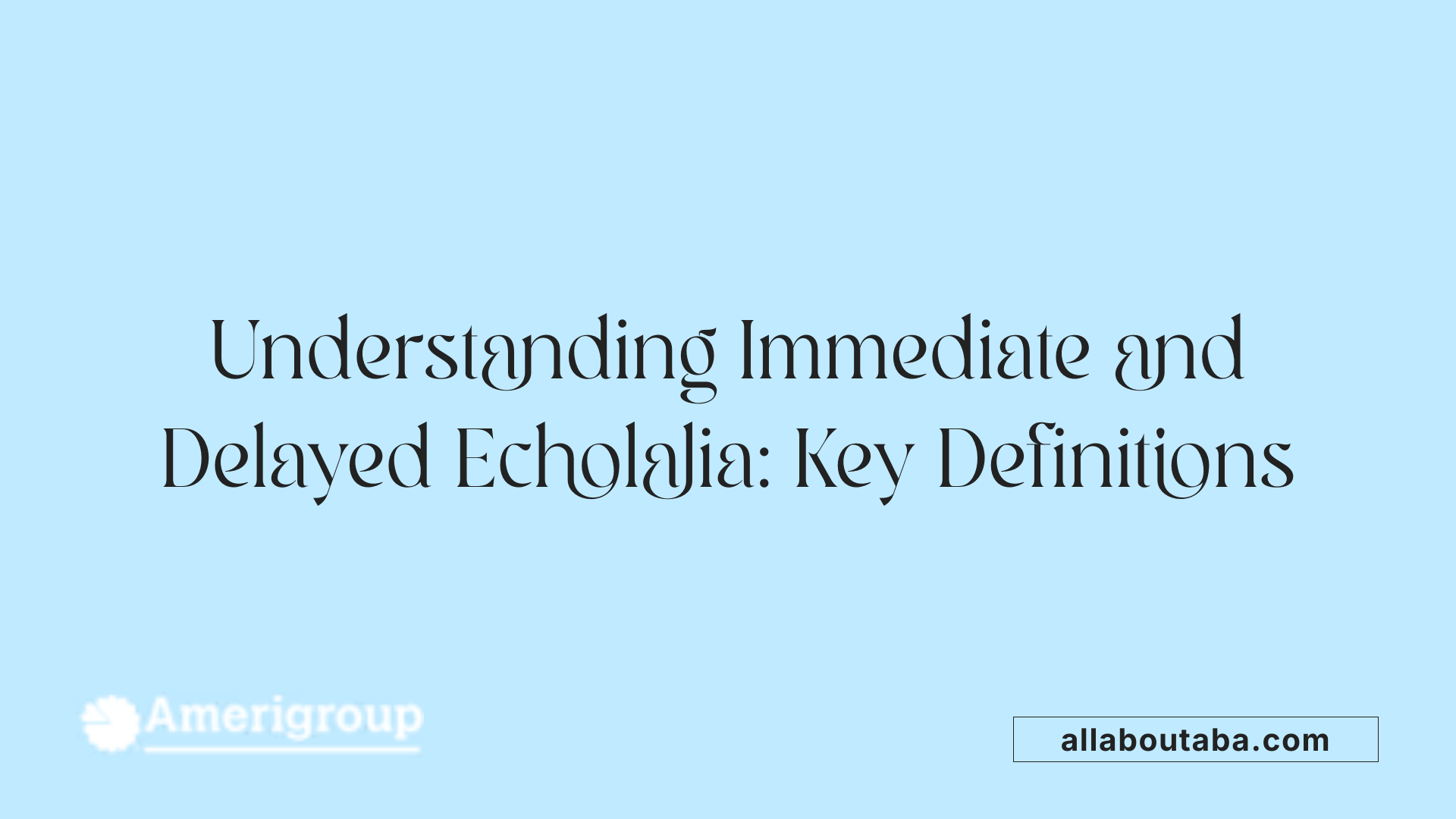
What is echolalia?
Echolalia is the unsolicited repetition of words or phrases that a person has heard. It is commonly observed in various neurodevelopmental and neurological conditions, prominently in autism spectrum disorder (ASD). This behavior is especially notable as a part of language development in toddlers but becomes pathological when it persists beyond age 3 in many cases.
Immediate echolalia
Immediate echolalia refers to the repetition of words or phrases immediately after hearing them. This form often functions as participation in conversation, processing, or turn-taking and plays a significant communicative role for those with ASD.
Delayed echolalia
Delayed echolalia involves repeating a phrase or set of words after a time delay which can span from minutes to even years. This type may stem from various sources such as TV shows, videos, or past conversations. Delayed echolalia serves interactive purposes, like making requests or protests, or non-interactive roles such as self-regulation and play.
Sources of repeated phrases
The phrases repeated in echolalia can originate from recent interactions or long-past auditory experiences, including media sources and previous social exchanges. This diversity in sources reflects the complexity of echolalia and its use as an adaptive communication tool in individuals with ASD.
Understanding these distinctions helps in appreciating the multifaceted communicative functions echolalia serves, and aids in shaping effective therapeutic interventions.
Echolalia as a Typical Part of Language Development
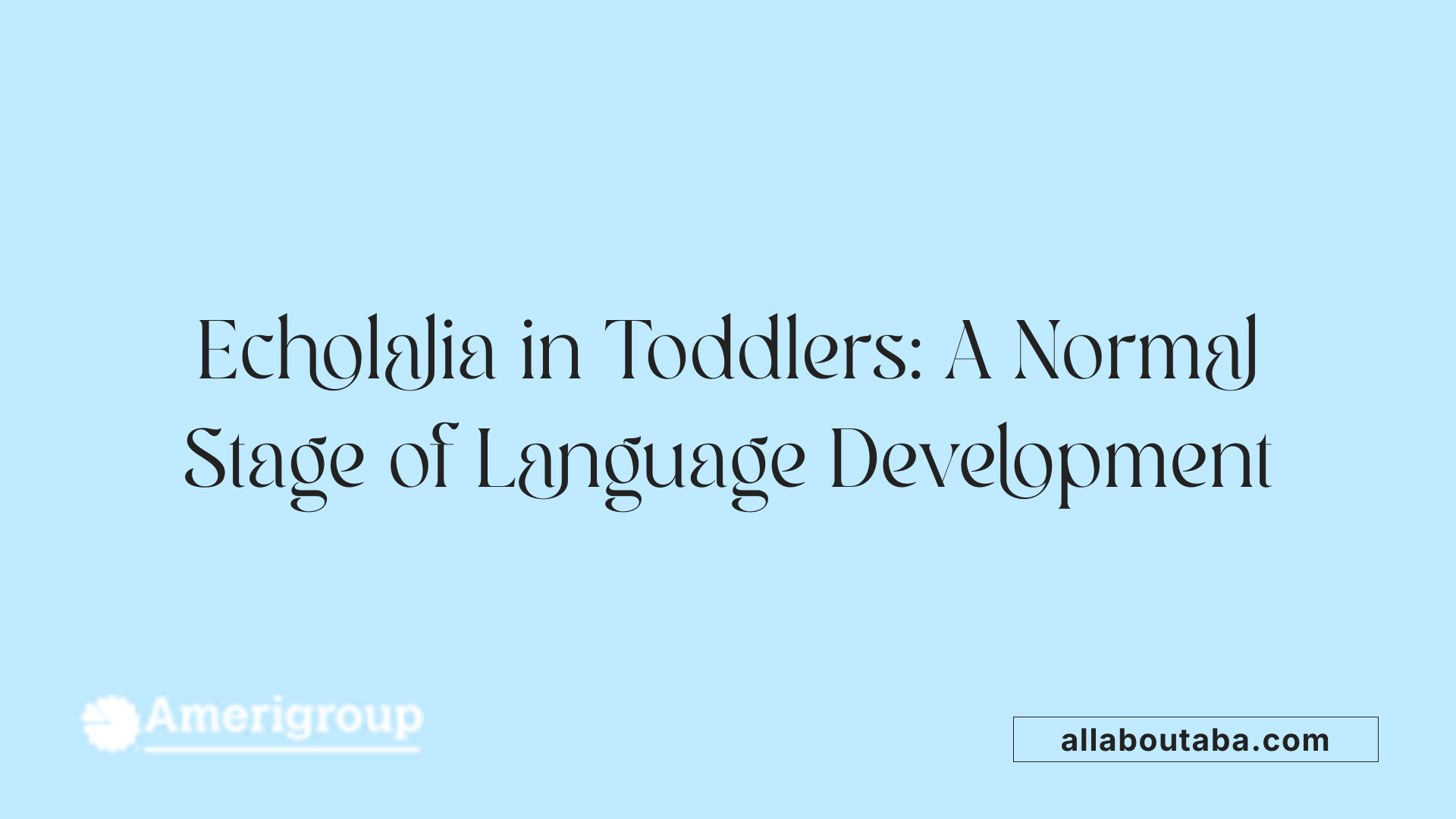
What is Echolalia in Toddlers?
Echolalia is the unsolicited repetition of words or phrases heard by a child. In toddlers, it commonly appears as a normal part of early language learning. Young children use echolalia to practice sounds, mimic speech patterns, and begin understanding language structure and vocabulary.
How Does Echolalia Develop Over Time?
During the first two years of life, echolalia generally improves as toddlers develop more spontaneous and functional speech. It serves as a natural bridge from simple repetition to meaningful communication, helping children grasp conversational turn-taking, sentence formation, and social interaction.
When Does Echolalia Become Pathological?
Echolalia is not always problematic. However, if it persists beyond the age of three, it is often considered pathological. Persistent echolalia at this stage may be associated with neurodevelopmental conditions such as autism spectrum disorder (ASD). Around 75% of children with ASD exhibit echolalia, which can be either immediate (repeating speech right away) or delayed (repeating phrases after some time).
In summary, echolalia in toddlers is generally a healthy, expected phase of language acquisition. It transitions naturally as language skills grow but may warrant attention if it continues beyond early childhood, signaling the need for further assessment and intervention.
Prevalence of Echolalia in Autism Spectrum Disorder
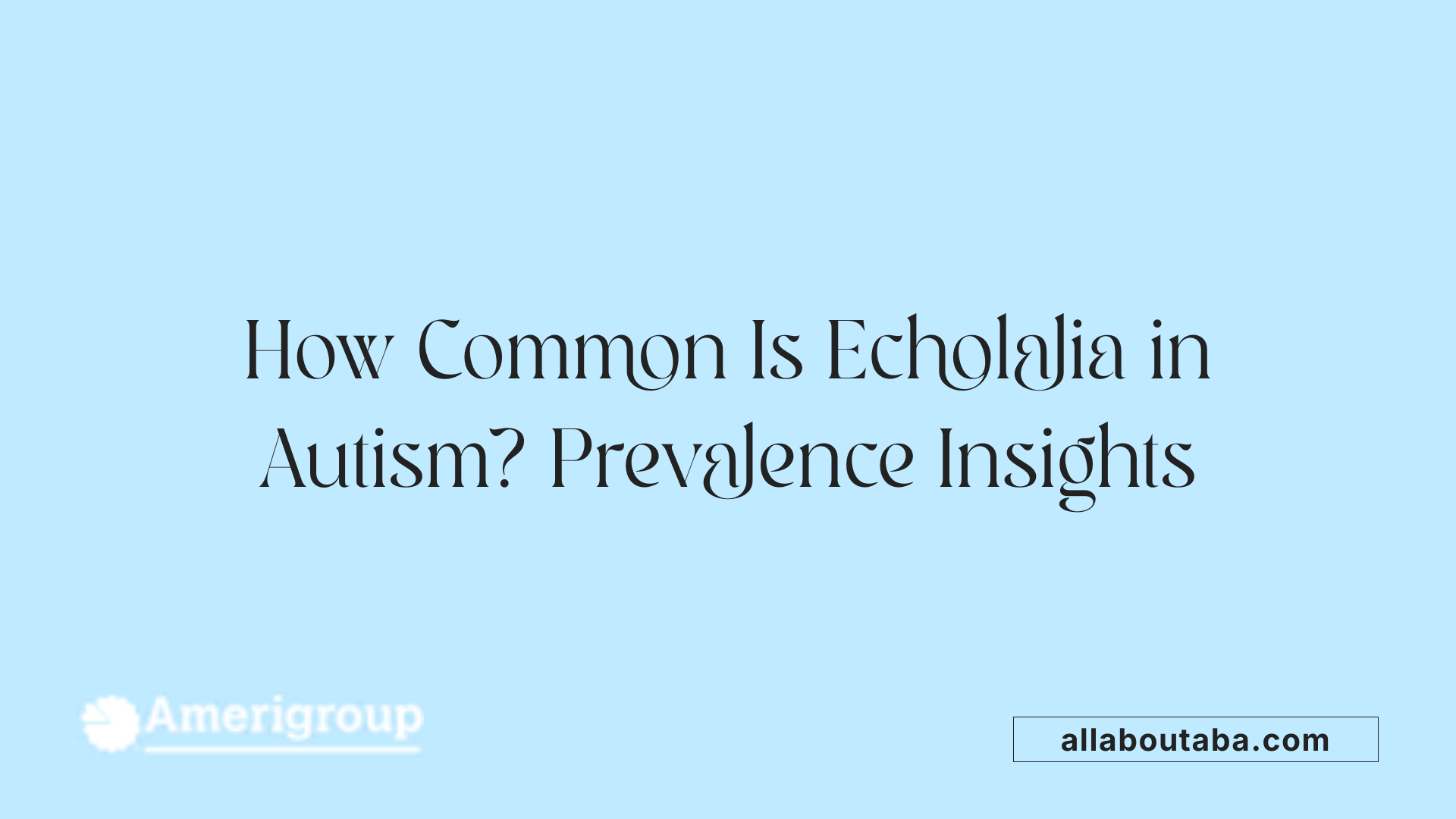
How common is echolalia among individuals with autism spectrum disorder?
Echolalia is frequently observed in children with autism spectrum disorder (ASD), with reported prevalence rates varying significantly across studies. Estimates range widely from about 25% to as high as 91%, reflecting differences in study designs, definitions, and measurement approaches.
Why does prevalence estimates for echolalia vary so widely?
The variation is partly due to the lack of standardized criteria and consistent measurement methods used by researchers. Many studies rely on outdated or non-standardized tools that may not capture all manifestations of echolalia accurately. This inconsistency complicates efforts to pinpoint its true frequency among autistic populations.
How is echolalia classified in diagnostic frameworks?
While echolalia has long been recognized as a characteristic speech pattern in autism, the Diagnostic and Statistical Manual of Mental Disorders, Fifth Edition (DSM-5) categorizes it not directly as a communication deficit but rather as part of the 'restricted, repetitive patterns of behavior' characteristic of ASD. This reclassification reflects a shift in understanding echolalia's role—from solely an impairment to a potentially functional behavior.
Understanding these prevalence rates and diagnostic nuances is essential for clinicians and educators to identify echolalia within the autism spectrum appropriately. Moreover, consistent definitions and improved measurement tools are needed to advance research and tailor interventions effectively.
The Functional Roles of Echolalia in Autism Communication
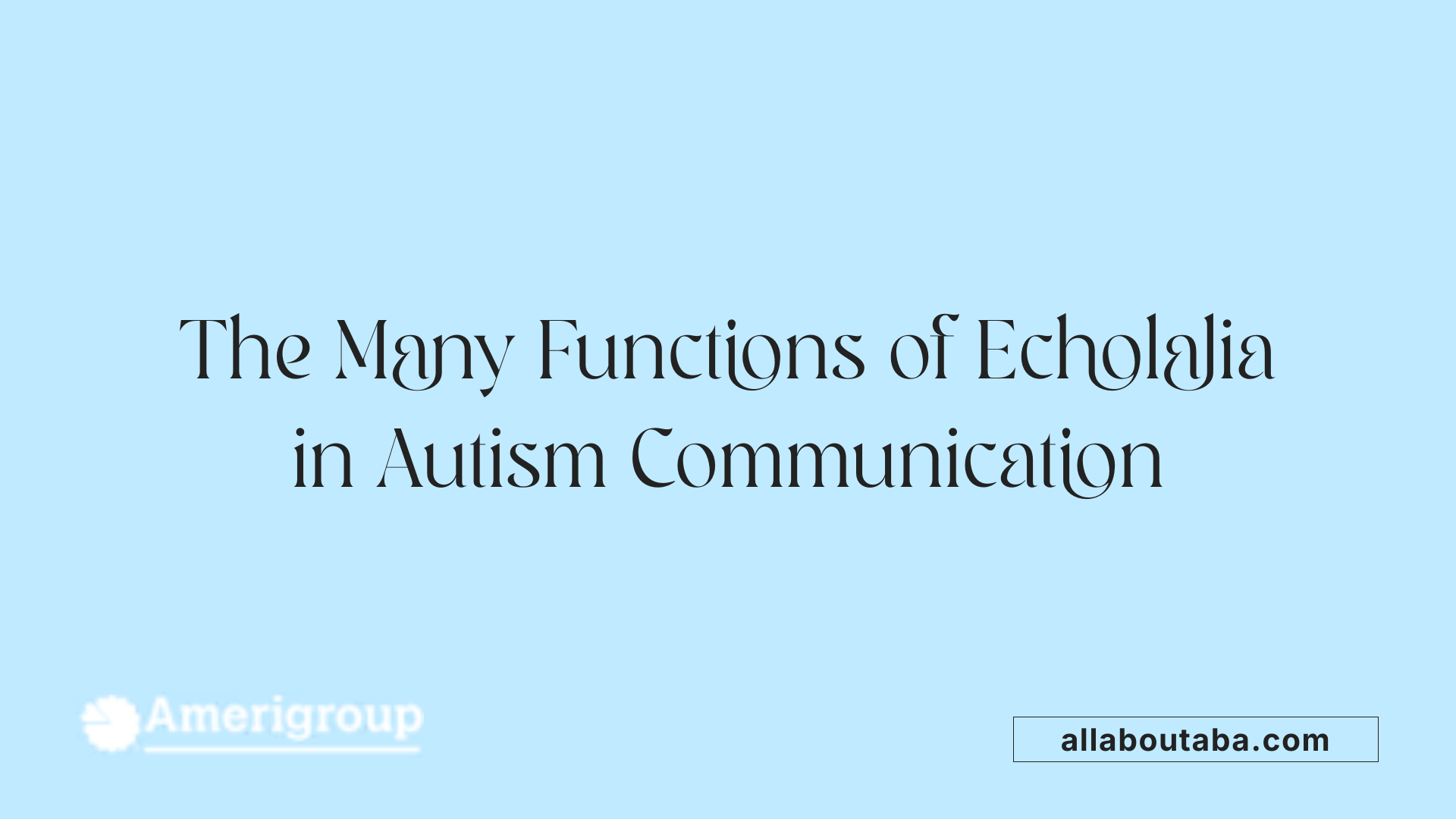
What Communicative Functions Does Echolalia Serve?
Echolalia in children with autism spectrum disorder (ASD) is more than mere repetition; it functions as an important tool for communication. Immediate and delayed echolalia help children initiate social interaction, make requests, or convey information. For instance, repeating a phrase right after hearing it (immediate echolalia) can signal a desire to participate in conversation or process what was just said.
How Does Echolalia Facilitate Turn-Taking?
Echolalia supports social engagement by acting as a turn-taking mechanism during communication. When children echo phrases, they can signal their readiness to respond or keep the conversation going. This role is particularly useful for children with ASD who may find spontaneous language generation challenging.
In What Ways Is Echolalia Used for Requesting?
Children often use delayed echolalia to express requests or protest. Interactive delayed echolalia functions imperatively in this context, enabling the child to communicate needs such as asking for an item or expressing refusal, even if the exact words come from previously heard speech rather than original sentences.
What Role Does Echolalia Play in Self-Regulation?
Non-interactive delayed echolalia is commonly used for calming, self-stimulation, and self-regulation. Repeating familiar phrases helps children with ASD manage anxiety or sensory overload by providing a predictable and comforting verbal routine.
Overall, echolalia serves multiple adaptive functions in autism communication. Recognizing these functions allows therapists and caregivers to support language development effectively and tailor interventions that harness echolalia’s communicative potential rather than simply trying to eliminate it.
How Echolalia Supports Language Learning and Social Interaction

Understanding language structure
Echolalia allows children, particularly those with autism spectrum disorder (ASD), to engage with language by repeating heard words and phrases. This repetition helps them familiarize themselves with language patterns and organization, thereby reinforcing their grasp of language structure.
Grammar and vocabulary acquisition
Through echolalic speech, children can practice the grammar and vocabulary of their environment. Repeating phrases heard in everyday contexts enables them to internalize new words and syntactical arrangements, contributing to their expanding linguistic repertoire.
Bridge to complex speech
For many children with ASD, echolalia acts as a stepping stone toward more sophisticated verbal communication. By imitating language initially, children gradually move to using spontaneous and functional speech. This progression underscores echolalia as not just a repetitive behavior but a vital developmental phase in language acquisition.
Social engagement
Beyond language learning, echolalia serves important social functions. Immediate echolalia can facilitate participation in conversations, signaling turn-taking and engagement. Delayed echolalia helps in initiating social contacts, making requests, and self-regulating emotions, which are critical aspects of social interaction and communication for autistic children.
Immediate Versus Delayed Echolalia: Different Purposes

Interactive Immediate Echolalia
Immediate echolalia involves the verbatim repetition of words or phrases right after hearing them. In children with autism spectrum disorder (ASD), this type of echolalia plays a dynamic role in communication. It can serve interactive purposes such as participating in conversations, taking turns, or processing language in real time. This immediate repetition helps children engage with others and facilitates social interaction, making it a functional speech behavior rather than mere mimicking.
Non-Interactive Delayed Echolalia
In contrast, delayed echolalia occurs after a time gap, ranging from minutes to even years. Non-interactive delayed echolalia does not directly engage others but serves internal functions. Children with ASD may use it during play or to calm themselves, reflecting its role in self-regulation and emotional stabilization. It is a way for them to recall previously heard phrases or sounds without necessarily seeking immediate social interaction.
Self-Stimulation and Calming Functions
Both immediate and delayed echolalia can serve self-stimulatory or calming purposes. For example, delayed echolalia is often employed by children to soothe anxiety or structure their environment. Such repetitions provide a sense of predictability and security. This behavior underlines echolalia's adaptive nature, showing that it is not purely a communication barrier but a meaningful mechanism for managing internal states.
Multidisciplinary Approach to Managing Echolalia

Role of Speech-Language Pathologists
Speech-language pathologists play a central role in assessing and managing echolalia in children with autism spectrum disorder (ASD). They focus on developing functional communication skills by using techniques such as verbal modeling, script training, and applying visual cues. These specialists tailor interventions to transform echolalia from a repetitive behavior into a communicative tool, helping children practice language structure and understand vocabulary.
Contributions of Neurodevelopmental Specialists
Neurodevelopmental specialists contribute by providing comprehensive evaluations to understand the underlying neurological and developmental aspects of echolalia. They collaborate closely with other team members to ensure interventions are aligned with the child's developmental profile and needs. Their expertise supports the integration of therapeutic strategies that encourage language acquisition and self-regulation.
Psychologists and Educators' Roles
Psychologists assist by addressing behavioral components related to echolalia, using applied behavior analysis (ABA) techniques like cue-pause-point training and reinforcement strategies. Their involvement helps improve social communication and reduces nonfunctional repetitive speech.
Educators complement these efforts by implementing structured classroom routines, using repetition and visual aids, and fostering an inclusive environment for children with echolalia. Proper training enables educators to support language development effectively, making learning more accessible and engaging.
Together, this multidisciplinary team creates a holistic intervention plan that embraces echolalia's communicative potential, striving for improved social interaction and language outcomes in children with autism.
Applied Behavior Analysis (ABA) Therapy: An Overview
What is Applied Behavior Analysis (ABA) therapy?
Applied Behavior Analysis (ABA) therapy is a scientifically based approach aimed at understanding and modifying behavior through examining the interactions between environment and actions. This method involves assessing why behaviors occur—whether for attention, escape, or other reasons—and then creating personalized interventions to encourage positive behaviors while reducing undesired ones.
How is behavior assessed in ABA?
Behavior assessment is central to ABA, helping therapists identify the triggers and purposes of certain behaviors. This understanding allows the design of targeted strategies that address individual needs and promote learning in meaningful ways.
What techniques are used in ABA?
ABA employs a variety of techniques such as positive reinforcement, which rewards desired behaviors to increase their frequency. Prompting guides individuals to perform tasks correctly, while natural learning opportunities help embed new skills in everyday routines. Specific interventions for echolalia, common in children with autism spectrum disorder (ASD), include cue-pause-point training, script training, visual cues, verbal modeling, and reinforcement strategies. These techniques help individuals transition from repetition to functional communication.
In what settings is ABA therapy applied?
ABA therapy is flexible and can be delivered across multiple environments—home, school, or community settings. It is tailored to meet each individual's unique needs and goals, making it an adaptable and effective treatment option for various behavioral challenges, especially for those with ASD.
ABA therapy's evidence-based framework and individualized focus contribute significantly to improving communication, social skills, and daily living abilities in children exhibiting behaviors like echolalia, ultimately supporting better developmental outcomes.
ABA Therapy’s Impact on Individuals with Autism
How does ABA therapy help individuals with autism?
Applied Behavior Analysis (ABA) therapy plays a crucial role in supporting individuals with autism by focusing on reinforcing positive behaviors and reducing challenging ones. This evidence-based approach uses techniques such as positive reinforcement, modeling, and environmental modifications tailored to each child's specific needs.
ABA targets essential skills like communication, social interaction, self-care, and daily living activities. For children exhibiting echolalia, a common communication pattern in autism involving repeating phrases or sounds, ABA interventions have shown significant benefits. Strategies such as cue-pause-point training, script training, visual cues, verbal modeling, and reinforcement help encourage functional speech and develop effective communication.
Reinforcement of Positive Behavior
By reinforcing appropriate communication attempts and socially adaptive behavior, ABA therapy helps children move beyond echolalia to more spontaneous and context-appropriate language. Positive reinforcement strengthens desirable behaviors, increasing their frequency and promoting better interaction with peers and caregivers.
Skill Development
ABA programs focus on teaching foundational skills that build toward complex language and social competencies. Through consistent and structured interventions, children learn to understand language structure, grammar, and vocabulary. ABA therapy often uses task analysis and discrete trial training to break down skills into manageable steps, facilitating gradual progress.
Communication and Social Interaction Improvements
Through individualized programming, ABA facilitates improved pragmatic language skills, including turn-taking, requesting, protesting, and offering information. It also supports self-regulation by helping children utilize echolalia adaptively or transition to alternative communication methods like PECS or AAC devices.
Play-based Naturalistic Approaches
Modern ABA interventions incorporate naturalistic, play-based strategies to generalize skills to real-life environments. These approaches are engaging and encourage spontaneous use of language during everyday activities, fostering meaningful social engagement and enhancing communication outcomes.
In summary, ABA therapy stands as a comprehensive evidence-based method that effectively supports skill mastery and quality of life improvements in children with autism, particularly those exhibiting echolalia.
Who Provides ABA Therapy Services?
Behavior Analysts' Roles
ABA therapy services are primarily delivered by professionals specialized in behavior analysis. The central figure in this team is the Board Certified Behavior Analyst (BCBA), who brings expertise in designing and supervising tailored treatment programs. Their role involves conducting detailed assessments and adjusting strategies to suit individual therapeutic needs.
Supporting the BCBA are Board Certified Assistant Behavior Analysts (BCaBAs), who implement treatment plans under BCBA supervision. Registered Behavior Technicians (RBTs), supervised by BCBAs or BCaBAs, carry out direct intervention sessions and gather data to monitor progress.
Settings Where ABA is Delivered
ABA therapy is versatile and provided across multiple environments. These include specialized clinics focusing on autism and neurodevelopmental disorders, hospitals and healthcare centers, educational settings like schools, and community-based programs. This flexibility helps in adapting interventions within naturalistic or structured contexts, maximizing effectiveness.
Importance of Credentials
Credentialing ensures that those providing ABA therapy meet standardized professional criteria. Families seeking ABA services should prioritize providers with recognized certifications such as BCBA, BCaBA, and RBT. Credentials reflect formal education, supervised training, and adherence to ethical guidelines, which collectively contribute to high-quality care tailored to the individual’s needs.
The Typical ABA Therapy Process for Autism
Initial assessments
The process of Applied Behavior Analysis (ABA) therapy for autism starts with a thorough assessment by a Board Certified Behavior Analyst (BCBA). This involves detailed observations, interviews with the individual and family, and standardized tests. The goal is to understand the person's strengths, challenges, and specific behaviors that will be targeted in therapy.
Individualized plans
Following assessment, the BCBA develops a tailored treatment plan. This plan outlines clear, measurable goals focused on enhancing communication skills, social interaction, daily living abilities, and reducing any problematic behaviors. Each plan is unique to meet the individual’s needs and learning style.
Implementation and data collection
Therapy sessions are structured and goal-directed, usually delivered one-on-one by Behavior Technicians under BCBA supervision. Techniques such as positive reinforcement, prompting, and modeling are used. During sessions, data are continuously collected to track progress toward goals, ensuring interventions are effective.
Monitoring and family involvement
ABA therapy includes regular evaluations where the BCBA reviews data and adjusts the treatment plan as needed. Family involvement is a key aspect; parents and caregivers are trained to support skill generalization across home, school, and community settings. Consistent collaboration ensures a comprehensive approach to the individual's growth and development.
Benefits of Early ABA Intervention for Children with Autism
What Are the Benefits of Early Intervention with ABA Therapy?
Early intervention with Applied Behavior Analysis (ABA) therapy is crucial for children with autism. It harnesses the brain's high plasticity during the early years, a period when neural connections are most adaptable and receptive to learning new skills.
ABA therapy helps improve communication by fostering functional speech and social interaction skills. It also aids in managing behavioral challenges through reinforcement and structured teaching, leading to better self-regulation.
Starting therapy early boosts the development of essential daily living skills, such as independence and emotional control. This foundation supports long-term benefits, including higher cognitive abilities, improved language and motor skills, and greater overall quality of life.
Moreover, timely ABA intervention can lessen the severity of autism symptoms over time, adapting the child's learning and interaction trajectories in more positive directions. This personalized approach has been linked to enhanced developmental outcomes and increased potential for success in educational and social settings.
Addressing Challenges and Criticisms of ABA Therapy
Are there any criticisms or challenges associated with ABA therapy?
Applied Behavior Analysis (ABA) therapy, widely used for managing echolalia and other behaviors in autistic children, has gained strong scientific support for its effectiveness in teaching new skills and reducing harmful behaviors. However, it also faces notable criticisms and challenges that are important to consider.
Overemphasis on compliance
One primary concern is that ABA may sometimes overemphasize compliance, prioritizing behavioral conformity over individual preferences or neurodiversity. This can potentially discourage natural behaviors such as stimming, which might be important for self-regulation.
Possible emotional distress
Critics highlight the risk of emotional distress or trauma when behaviors serving important emotional functions are suppressed. Although early ABA methods occasionally included aversive procedures, modern ABA practices prioritize ethical standards and have largely moved away from such approaches.
Ethical considerations
There are ethical questions concerning autonomy, identity, and respectful treatment of autistic individuals. Emphasizing behavioral conformity can conflict with acceptance of neurodiversity and children's rights to express their authentic selves.
Evolution to naturalistic approaches
To address these challenges, contemporary ABA therapy has evolved toward more individualized, play-based, and naturalistic methods. These approaches focus on functional communication and skill-building while respecting the child’s comfort and emotional needs.
In summary, while ABA remains a cornerstone of autism communication therapy, ongoing efforts aim to balance effectiveness with ethical, emotional, and individual considerations to optimize outcomes and well-being for children with echolalia and related communication challenges.
Functional Analysis of Echolalia to Inform Interventions
Understanding communicative functions
Echolalia, the repetition of heard words or phrases, plays diverse communicative roles in children with autism spectrum disorder (ASD). Immediate echolalia helps in turn-taking and processing conversations, while delayed echolalia may recall past phrases from media or conversations to establish social contact, request items, express protest, or share information. Recognizing these interactive and non-interactive functions aids in discerning the intentions behind echolalic speech.
Adaptive mechanisms
Delayed echolalia serves as an adaptive communication strategy for children with ASD. It supports interaction with others, helps in self-regulation, and enables expression of needs. For instance, non-interactive delayed echolalia is often used by children for calming or play, indicating its role beyond mere repetition. This understanding reframes echolalia as an important tool rather than a communication deficit.
Tailoring therapy goals
Analyzing the functional aspects of echolalia guides therapists in designing personalized interventions. Speech-language pathologists and behavioral specialists can focus on enhancing the communicative functions served by echolalia, such as turning echolalic phrases into purposeful language use. Applied behavior analytic (ABA) techniques combined with visual cues and reinforcement are tailored to support the child's language development goals. This individualized approach promotes meaningful communication rather than suppression of echolalic behavior.
Supporting Communication Beyond Echolalia: Tools and Strategies
How can visual aids support children with echolalia?
Visual aids provide clear, concrete representations of language and concepts, helping children with echolalia to better understand and process communication. These aids include pictures, symbols, charts, or gestures that can make abstract ideas more accessible. In classrooms and therapy sessions, visual supports help scaffold language learning and promote comprehension, reducing reliance on repeated phrases.
Why is simplifying language important?
Simplifying language involves using clear, concise, and consistent vocabulary and sentence structures. This approach reduces language complexity, making it easier for children with echolalia to grasp meaning and respond effectively. Caregivers and educators often break down instructions into manageable parts and avoid idioms or complex expressions to enhance understanding and encourage spontaneous communication.
What role do routines play in communication?
Creating predictable routines provides a structured environment where children with echolalia can anticipate communication demands and practice language skills with confidence. Consistent daily schedules and familiar activities foster security and allow children to rehearse functional language in meaningful contexts, promoting gradual transition from repeated utterances to more original speech.
Which alternative communication methods are effective?
Augmentative and Alternative Communication (AAC) systems, such as the Picture Exchange Communication System (PECS) and speech-generating devices, offer effective alternatives for children who struggle with verbal expression. PECS enables children to communicate needs and preferences by exchanging pictures, while AAC devices produce spoken words from button presses or touchscreen selections. These tools empower children to express themselves independently and reduce frustration related to communication barriers.
Together, these strategies form a comprehensive support framework that complements therapeutic interventions targeting echolalia. They enable children with autism to develop varied and functional communication skills beyond repetition, fostering greater social interaction and autonomy.
Role of Educators in Supporting Children with Echolalia
Using repetition and visual cues
Educators play a crucial role in supporting children with echolalia, particularly those with autism spectrum disorder. One effective strategy is the consistent use of repetition and visual aids. Repeating key words or phrases and pairing them with pictures or symbols helps reinforce understanding and supports the child's ability to connect language with meaning.
Structured routines
Implementing structured routines in the classroom creates a predictable environment that can alleviate anxiety and encourage communication. Children with echolalia often respond well to clear, consistent schedules where language use is embedded within familiar activities. This structure helps them practice functional speech within meaningful contexts.
Inclusive classroom strategies
Inclusive strategies such as grouping children for cooperative tasks and encouraging peer interaction foster social engagement. Educators can facilitate communication by allowing time for children to use echolalia as a tool for turn-taking and self-expression, recognizing its role beyond mere repetition.
Teacher training
Proper training for educators is essential to effectively implement these strategies. Understanding the functional uses of echolalia enables teachers to adapt their communication methods and to support each child's unique language development needs. Training ensures educators can differentiate between echolalia as a communicative tool versus a stereotyped behavior, thus enhancing intervention outcomes.
Echolalia in Other Neurological and Neurodevelopmental Conditions
Occurrence in Aphasia
Echolalia can appear in individuals with aphasia, a language impairment resulting from brain damage such as stroke or traumatic injury. In aphasia, echolalia may manifest as involuntary repetition of words or phrases heard from others. This phenomenon is believed to stem from disrupted language processing pathways, where patients echo speech without full comprehension, often as a compensatory or automatic response.
Echolalia in Gilles de la Tourette Syndrome
In Gilles de la Tourette syndrome, echolalia is documented as part of complex vocal tics. Unlike autism, where echolalia may have communicative intent, in Tourette's it often appears as spontaneous, non-contextual repetition of sounds or words, reflecting the underlying motor and vocal tic mechanisms characteristic of the disorder.
Stroke-Related Echolalia
Stroke survivors with damage to specific brain regions, especially in the left hemisphere, can exhibit echolalia. This repetition often occurs in the early recovery phase and is associated with deficits in speech initiation and processing. The presence of echolalia in stroke patients helps clinicians understand aphasia subtypes and tailor rehabilitation strategies that address these speech patterns.
Autoimmune and Neurodegenerative Disorders
Echolalia has also been observed in certain autoimmune conditions affecting the central nervous system and in neurodegenerative diseases. These occurrences are less common but notable, with echolalia potentially indicating broader disruptions in neural circuits governing speech production and regulation. Its presence can signal advanced disease states or contribute to diagnostic assessments.
Understanding echolalia beyond autism highlights its diverse neurological origins. This reinforces the importance of comprehensive evaluation and multidisciplinary approaches in managing echolalia across different conditions.
Future Directions in Echolalia Research and Autism Therapy
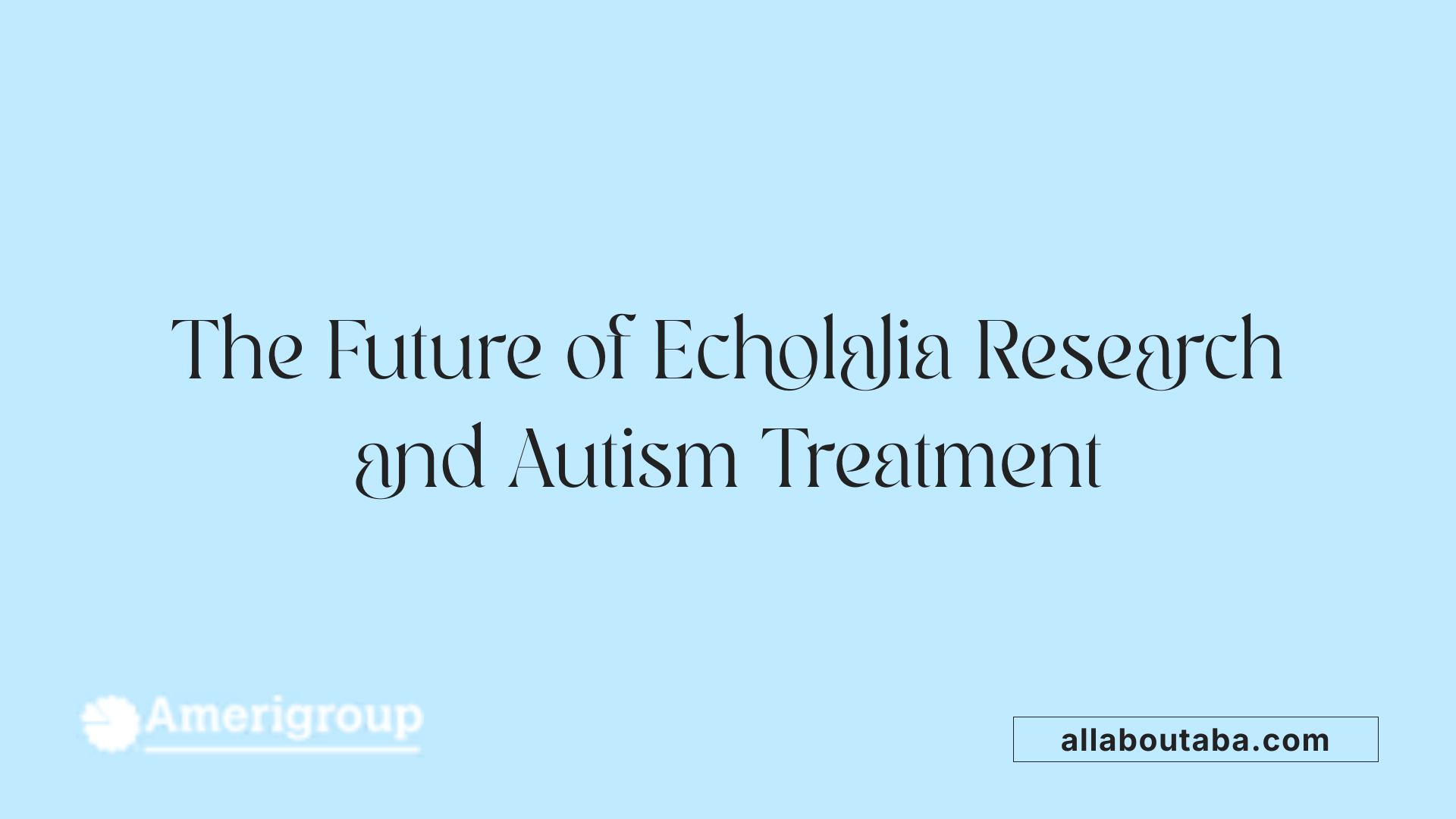
Need for consistent definitions and measurements
Current echolalia research is challenged by varied definitions and inconsistent measurement methods, causing wide prevalence estimates from 25% to 91% among autistic children. Future studies must establish standardized definitions and rigorous measurement protocols. This consistency will allow for more reliable comparisons across studies and a clearer understanding of echolalia's role in autism.
Larger representative studies
Most existing studies suffer from small sample sizes or outdated collection methods, limiting generalizability. Future research should prioritize larger and more representative participant samples to capture the diversity of echolalia expression among autistic populations. This approach will yield more precise prevalence data and a fuller spectrum of functional echolalia behaviors.
Integrating findings into practice
Emerging insights portray echolalia as a potentially adaptive communication strategy rather than merely a repetitive behavior. Therapeutic frameworks, including speech therapy and applied behavior analysis, must be informed by this evolving understanding. Integrating research outcomes into multidisciplinary intervention design will enhance support for communication development, enabling personalized and functionally effective therapy for children with autism exhibiting echolalia.
Advancing research with these priorities will ultimately improve assessment protocols, intervention efficacy, and family and educator guidance concerning echolalia in autism spectrum disorder.
Embracing Echolalia in Autism Communication: A Path Forward
Echolalia, long viewed as a barrier in autism communication, is increasingly recognized as a complex, adaptive behavior with important communicative functions. Understanding its types, roles, and how it can be harnessed through targeted interventions provides vital insights for therapists, educators, and families. The implementation of Applied Behavior Analysis (ABA) therapy, alongside multidisciplinary support and individualized strategies, helps transform echolalia from a challenge into a bridge toward meaningful language and social engagement. Through continued research, ethical practice evolution, and holistic support, echolalia stands as a promising gateway into unlocking the communicative potential of individuals with autism.
References
- Echolalia - StatPearls - NCBI Bookshelf - NIH
- A systematic review of interventions for echolalia in autistic ...
- Echolalia in Children with Autism, What It Is and How to ...
- Prevalence of Echolalia in Autism: A Rapid Review ...
- (PDF) The Role of Delayed Echolalia Produced by ...
- Early Intervention for Autism | NICHD - NIH
- The Benefits of Early Intervention and Full-Time ABA Therapy







